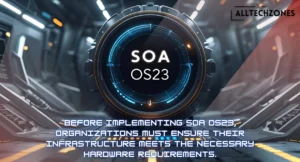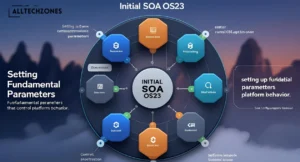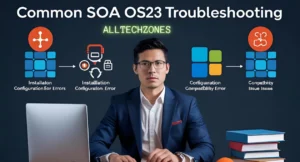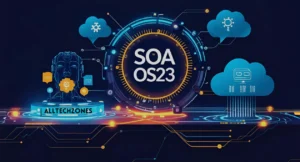In the rapidly evolving landscape of enterprise software architecture, Service-Oriented Architecture (SOA) continues to play a crucial role in modern application development and system integration. SOA OS23 represents the latest iteration in this technological evolution, offering enhanced capabilities, improved performance, and advanced features that address the complex needs of today’s distributed computing environments. This comprehensive guide explores everything you need to know about SOA OS23, from its core features to implementation strategies and optimization techniques.
Understanding SOA OS23: An Overview
SOA OS23 is a sophisticated service-oriented architecture platform designed to facilitate seamless integration, communication, and management of distributed services across enterprise environments. Building upon the foundational principles of service-oriented computing, this platform introduces advanced capabilities that enable organizations to create more flexible, scalable, and maintainable software systems.
The platform addresses common challenges faced by enterprises implementing service-oriented architectures, including service discovery, load balancing, security management, and performance monitoring. By providing a comprehensive framework for service management and orchestration, SOA OS23 empowers organizations to maximize the benefits of distributed computing while minimizing complexity and operational overhead.
Key SOA OS23 Features and Capabilities
Enhanced Service Management
One of the most significant SOA OS23 features is its advanced service management capabilities. The platform provides comprehensive tools for service lifecycle management, including service registration, discovery, versioning, and retirement. These features enable organizations to maintain clear visibility into their service ecosystem while ensuring proper governance and control.
The service registry component offers centralized management of service metadata, endpoints, and dependencies. This centralization simplifies service discovery processes and enables more effective monitoring and troubleshooting of distributed applications. Additionally, the platform supports multiple service communication protocols, ensuring compatibility with existing systems and technologies.
Advanced Security Framework
Security remains a paramount concern in distributed computing environments, and SOA OS23 addresses this through its comprehensive security framework. The platform implements multiple layers of security controls, including authentication, authorization, encryption, and audit logging.
The SOA OS23 security settings provide granular control over access permissions, enabling administrators to define precise security policies for different services and user groups. The platform supports industry-standard security protocols and can integrate with existing identity management systems, ensuring seamless security implementation across the enterprise.
Performance Monitoring and Analytics
Real-time performance monitoring capabilities are essential for maintaining optimal service performance in distributed environments. SOA OS23 includes sophisticated monitoring tools that track service response times, throughput, error rates, and resource utilization across the entire service ecosystem.
The analytics dashboard provides comprehensive insights into service performance trends, helping administrators identify bottlenecks, optimize resource allocation, and proactively address potential issues. These monitoring capabilities are crucial for maintaining service level agreements and ensuring consistent user experiences.
For more Tech related blogs keep visiting Alltechzones.
Integration and Interoperability
SOA OS23 excels in its ability to integrate with diverse systems and technologies. The platform supports multiple communication protocols, data formats, and integration patterns, making it suitable for complex enterprise environments with heterogeneous technology stacks.
The SOA OS23 integration examples demonstrate how the platform can connect legacy systems with modern applications, cloud services with on-premises infrastructure, and different vendor solutions within a unified architecture. This flexibility is essential for organizations undergoing digital transformation initiatives.
SOA OS23 System Requirements and Prerequisites
Hardware Requirements

Before implementing SOA OS23, organizations must ensure their infrastructure meets the necessary hardware requirements. The platform requires adequate processing power, memory, and storage capacity to support the anticipated service load and concurrent user base.
Typical minimum requirements include multi-core processors with sufficient clock speed to handle service orchestration tasks, adequate RAM to support in-memory caching and service execution, and high-performance storage systems to ensure optimal data access speeds. Network infrastructure must also support the expected communication volumes between distributed services.
Software Dependencies
The SOA OS23 system requirements include specific software dependencies that must be installed and configured before platform deployment. These typically include compatible operating systems, database management systems, web servers, and runtime environments for various programming languages.
Organizations should carefully review version compatibility matrices to ensure all components work together seamlessly. Additionally, certain third-party libraries and frameworks may be required depending on the specific features and integrations planned for the implementation.
Environmental Considerations
Successful SOA OS23 deployment requires careful consideration of the target environment, including network topology, security policies, and existing system integrations. Organizations should conduct thorough environmental assessments to identify potential conflicts or compatibility issues before beginning implementation.
SOA OS23 Installation Guide and Setup Process
Pre-Installation Planning
The SOA OS23 installation guide emphasizes the importance of thorough planning before beginning the installation process. Organizations should define their service architecture, identify integration requirements, and establish governance policies before proceeding with technical implementation.
Planning should include capacity sizing based on expected service loads, network configuration to support service communication, and security architecture to protect sensitive data and operations. This preparation phase is crucial for ensuring successful implementation and optimal performance.
For more Tech related blogs keep visiting Alltechzones.
Step-by-Step Installation Process
The installation process typically begins with environment preparation, including operating system configuration, dependency installation, and network setup. The SOA OS23 installer provides guided setup wizards that simplify the installation process while ensuring proper configuration of all components.
Database initialization is a critical step that involves creating necessary schemas, configuring connection parameters, and establishing initial administrative accounts. The installer typically handles these tasks automatically while providing options for customization based on specific organizational requirements.
Service configuration follows database setup and involves defining service endpoints, security policies, and integration parameters. The platform provides templates and configuration wizards to streamline this process while ensuring proper setup of all necessary components.
Post-Installation Verification
After completing the installation, administrators should perform comprehensive verification testing to ensure all components are functioning correctly. This includes testing service registration and discovery, verifying security controls, and validating integration connectivity.
Performance baseline testing is also recommended to establish reference points for future monitoring and optimization efforts. These baselines help administrators identify performance degradation and optimize system performance over time.
Configuration and Customization
Basic Configuration Settings

Initial SOA OS23 configuration involves setting up fundamental parameters that control platform behavior. These settings include service discovery protocols, communication timeouts, security policies, and logging configurations.
The SOA OS23 configuration tips emphasize the importance of aligning configuration settings with organizational requirements and operational procedures. Proper configuration ensures optimal performance while maintaining security and compliance standards.
Advanced Customization Options
Beyond basic configuration, SOA OS23 offers extensive customization capabilities that enable organizations to tailor the platform to their specific needs. These customizations may include custom service adapters, specialized security providers, and integration connectors for proprietary systems.
Custom workflow definitions allow organizations to implement specific business processes and approval procedures within the service management framework. These customizations help ensure that the platform aligns with existing operational procedures and governance requirements.
Environment-Specific Adaptations
Different deployment environments may require specific configuration adaptations. Development environments might emphasize ease of testing and debugging, while production environments prioritize performance, security, and reliability.
The platform supports environment-specific configuration profiles that enable administrators to maintain consistent settings across different deployment stages while accommodating unique requirements for each environment.
Best Practices for SOA OS23 Implementation
Service Design Principles
Effective SOA OS23 implementation requires adherence to established service design principles. Services should be designed with clear interfaces, well-defined contracts, and appropriate granularity to maximize reusability and maintainability.
Best practices for SOA OS23 include implementing proper error handling, designing for scalability, and ensuring loose coupling between services. These principles help create robust service architectures that can adapt to changing business requirements while maintaining operational stability.
Governance and Management
Establishing comprehensive governance frameworks is essential for successful SOA OS23 deployment. Governance policies should address service lifecycle management, version control, security standards, and performance requirements.
Regular governance reviews help ensure that service implementations continue to align with organizational standards and business objectives. These reviews also provide opportunities to identify optimization opportunities and address emerging challenges.
Performance Optimization Strategies
SOA OS23 performance optimization involves multiple aspects, including service design, infrastructure configuration, and operational procedures. Effective caching strategies can significantly improve response times and reduce system load.
Load balancing and scaling policies should be implemented to handle varying demand levels while maintaining consistent performance. The platform’s built-in monitoring capabilities help administrators identify performance bottlenecks and optimize system configuration accordingly.
Troubleshooting Common Issues
Installation and Configuration Problems

Common SOA OS23 troubleshooting scenarios include installation failures, configuration errors, and compatibility issues. The platform provides comprehensive logging capabilities that help administrators identify and resolve these problems quickly.
Database connectivity issues are among the most frequent problems encountered during installation. These issues typically involve incorrect connection parameters, insufficient database permissions, or network connectivity problems between application and database servers.
Service registration failures often result from incorrect endpoint configurations or network connectivity issues. The troubleshooting guide provides systematic approaches for diagnosing and resolving these problems.
Runtime and Performance Issues
Performance degradation can result from various factors, including inadequate resource allocation, network latency, or inefficient service implementations. The platform’s monitoring tools help administrators identify the root causes of performance problems.
Memory leaks and resource exhaustion are common issues in distributed service environments. Regular monitoring and proper resource management practices help prevent these problems from impacting system performance.
Integration and Connectivity Challenges
Integration problems often involve protocol mismatches, security configuration errors, or incompatible data formats. The SOA OS23 integration examples provide guidance for resolving common integration challenges.
Network connectivity issues can significantly impact service communication and overall system performance. Administrators should implement comprehensive network monitoring to quickly identify and resolve connectivity problems.
Updates and Version Management
SOA OS23 Updates and Maintenance
Regular updates are essential for maintaining security, performance, and functionality. The SOA OS23 updates process includes security patches, feature enhancements, and bug fixes that improve overall platform stability and capabilities.
Organizations should establish update schedules that balance the need for current functionality with operational stability requirements. Testing procedures should be implemented to validate updates before deployment to production environments.
Version Migration Strategies
Version migration planning helps ensure smooth transitions between platform versions while minimizing operational disruption. Migration strategies should include comprehensive testing, rollback procedures, and user training programs.
The platform provides migration tools and documentation that simplify the upgrade process while ensuring data integrity and configuration preservation.
Training and Documentation Resources
SOA OS23 Tutorials and Learning Materials
Comprehensive training programs are essential for successful SOA OS23 implementation and operation. The platform provides various learning resources, including interactive tutorials, video training sessions, and hands-on workshops.
SOA OS23 tutorials cover topics ranging from basic concepts to advanced configuration and troubleshooting techniques. These resources help users develop the skills necessary to effectively utilize the platform’s capabilities.
User Manual and Documentation
The SOA OS23 user manual download provides detailed reference information for all platform features and capabilities. This documentation includes configuration guides, API references, and troubleshooting procedures.
Regular documentation updates ensure that users have access to current information about platform features and best practices. Online documentation portals provide searchable access to comprehensive reference materials.
Future Developments and Roadmap
Emerging Technologies Integration

SOA OS23 continues to evolve to incorporate emerging technologies such as artificial intelligence, machine learning, and cloud-native architectures. These enhancements expand the platform’s capabilities while maintaining backward compatibility with existing implementations.
Containerization support and microservices architecture integration represent significant developments that align the platform with modern application development practices.
Community and Ecosystem Growth
The growing SOA OS23 community contributes to platform development through feedback, feature requests, and best practice sharing. This collaborative approach helps ensure that the platform continues to meet evolving enterprise requirements.
Third-party integration partnerships expand the platform’s ecosystem, providing additional capabilities and integration options for organizations with specific requirements.
For more Tech related blogs keep visiting Alltechzones.
Frequently Asked Questions (FAQs)
1. What are the minimum system requirements for SOA OS23 installation?
SOA OS23 requires a multi-core processor (minimum 4 cores recommended), at least 8GB of RAM (16GB recommended for production), and sufficient storage space for the application and database components (minimum 50GB). The platform supports major operating systems including Windows Server, Linux distributions, and Unix variants. Network connectivity with adequate bandwidth is essential for distributed service communication.
2. How long does a typical SOA OS23 installation take?
A standard SOA OS23 installation typically takes 2-4 hours for basic setup, including database configuration and initial service registration. Complex implementations with extensive customizations and integrations may require several days or weeks. The actual timeline depends on factors such as environment complexity, customization requirements, and integration scope. Proper planning and preparation can significantly reduce installation time.
3. Can SOA OS23 integrate with existing enterprise systems and databases?
Yes, SOA OS23 provides extensive integration capabilities supporting multiple protocols, data formats, and communication standards. The platform can connect with legacy systems, modern applications, various database systems, and cloud services. Pre-built connectors are available for common enterprise applications, while custom adapters can be developed for proprietary systems. The integration framework supports both synchronous and asynchronous communication patterns.
4. What security features does SOA OS23 provide for protecting sensitive data?
SOA OS23 implements comprehensive security measures including end-to-end encryption, multi-factor authentication, role-based access control, and detailed audit logging. The platform supports industry-standard security protocols such as OAuth, SAML, and SSL/TLS. Security policies can be configured at granular levels, controlling access to specific services and operations. Integration with existing identity management systems ensures consistent security implementation across the enterprise.
5. How does SOA OS23 handle performance monitoring and optimization?
The platform includes real-time monitoring capabilities that track service response times, throughput, error rates, and resource utilization. Performance dashboards provide comprehensive views of system health and service dependencies. Automated alerting notifies administrators of performance issues or threshold violations. Built-in optimization tools help identify bottlenecks and suggest improvements for better performance.
6. What training resources are available for SOA OS23 users and administrators?
SOA OS23 provides comprehensive training materials including interactive tutorials, video courses, documentation, and hands-on workshops. Online learning platforms offer self-paced training modules covering basic concepts through advanced administration topics. Instructor-led training sessions are available for organizations requiring structured learning programs. Community forums and knowledge bases provide additional support and best practice sharing.
Conclusion
SOA OS23 represents a mature and capable platform for implementing service-oriented architectures in enterprise environments. Its comprehensive feature set, robust security framework, and extensive customization capabilities make it suitable for organizations of various sizes and industries.
Successful implementation requires careful planning, proper configuration, and adherence to established best practices. Organizations that invest in proper training and governance frameworks can realize significant benefits from SOA OS23 deployment, including improved system integration, enhanced operational efficiency, and greater architectural flexibility.
Disclaimer: This blog post is for informational purposes only and does not constitute professional technical, business, or legal advice. While every effort has been made to ensure accuracy, readers should conduct their own research and consult with qualified professionals before making technology implementation decisions. Features, system requirements, and capabilities mentioned may be subject to change with software updates. Always review current documentation and terms of service when evaluating enterprise software solutions. Implementation results may vary based on specific organizational requirements and technical environments.
For more Tech related blogs keep visiting Alltechzones.
